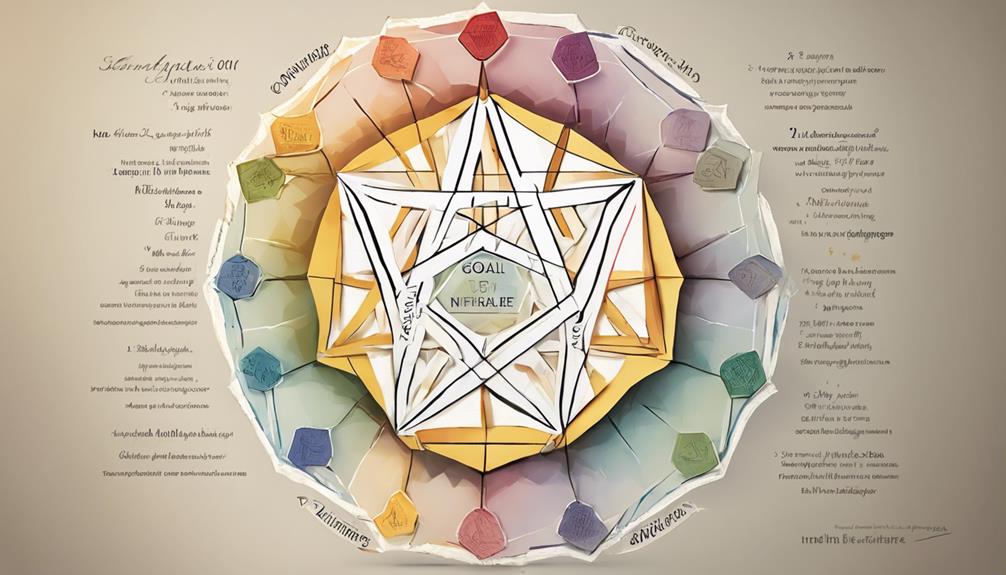Did you know that within the realm of the enneagram personality system, there are distinct subtypes that reveal fascinating nuances in behavior and mindset? One intriguing subtype is the counterphobic 6 enneagram, which offers a unique lens into the fears and strategies of the individual bearing this personality type. Whether you are a counterphobic 6 yourself or simply interested in understanding this dynamic subtype, read on to uncover the key traits and insights that make them tick.
Understanding the counterphobic 6 enneagram can provide valuable insights into the fears, needs, and strategies that drive their behavior. This article will delve into their core beliefs, desires, and fears, shedding light on their self-image and tactics. By exploring the counterphobic 6’s unique approach to navigating the world, we can gain a deeper understanding of their mindset and develop strategies for personal growth and resilience.
Key Takeaways:
- Counterphobic 6 enneagram is a distinct subtype that reveals unique behaviors and thought patterns.
- The core belief of a counterphobic 6 is that the world and people are unpredictable, unreliable, and dangerous.
- Counterphobic 6s have a strong need for security, guidance, and support.
- Their core fear is to be unsafe and without support or guidance.
- Counterphobic 6s employ strategies of planning, preparation, and seeking safety nets.
Type 6’s Core Belief
A counterphobic 6’s core belief revolves around a deep conviction that the world and people are unpredictable, unreliable, and dangerous. This belief shapes their perception and leads them to feel a strong need for support and safety. Counterphobic 6s may exhibit different wing types, such as wing seven or wing five, which further influences their behavior and coping mechanisms. Understanding this core belief is essential to gain insights into the mindset of counterphobic 6s.
Counterphobic 6s believe that they must do everything in their power to ensure their own security and protection. This core belief motivates their actions and influences their interactions with others. By acknowledging the significance of this belief, we can understand better why counterphobic 6s adopt specific behaviors and strategies to navigate a world they perceive as unpredictable and unsafe.
Type 6’s Core Need
Understanding the core need of a counterphobic 6 is crucial to comprehending their behavior and mindset. Counterphobic 6s have an innate need for security, guidance, and support. This need arises from their belief that the world is unpredictable and unsafe. In order to fulfill this need, counterphobic 6s often seek external sources to provide them with a sense of safety.
Counterphobic 6s may exhibit a strong reliance on authorities or systems, looking to them as a source of security and stability. Their need for security is deeply intertwined with their anxiety and fear, driving their behaviors and decision-making. By recognizing and acknowledging this core need, we can better understand the motivations and actions of counterphobic 6s.

Type 6’s Core Fear
As a counterphobic 6, the core fear that drives your behavior is the fear of being unsafe and lacking support or guidance. You have an innate aversion to being unprepared and unable to cope with the perceived dangers of the world around you. This fear is deeply ingrained within you and fuels your relentless pursuit of security and your instinct to seek out safety nets in every aspect of your life.
Understanding this core fear is crucial in comprehending the motivations and behaviors of counterphobic 6s. It sheds light on why you may go to great lengths to establish a sense of stability and protection, and why you may be highly vigilant and proactive in managing potential threats.
Counterphobic 6s’ Fear of Being Unsafe and Unsupported
“I have an inherent fear of feeling unsafe and unsupported. It drives me to constantly seek out security and reassurance. Being unprepared and unable to cope with the unpredictability of life terrifies me. I believe that if I let my guard down, something catastrophic will happen.”
This fear may manifest in various ways in your daily life. It can drive you to constantly anticipate and plan for worst-case scenarios, ensuring that you have safety measures in place. It might lead you to rely heavily on trusted authorities or seek guidance from others, as a way to alleviate the anxiety associated with feeling unsupported.

Embracing this understanding of your core fear empowers you to navigate your fear-driven mindset with awareness and compassion. By acknowledging your fear and addressing it directly, you can embark on a journey of personal growth and develop healthier coping mechanisms to manage and overcome your anxieties.
Type 6’s Strategy and Tactics
Counterphobic 6s employ a strategic approach in their pursuit of love, security, and safety. Central to their behavior is a deeply rooted fear of being unable to cope with the challenges in a world they perceive as unpredictable and unreliable. To navigate this fear, counterphobic 6s utilize various tactics aimed at ensuring their well-being and minimizing potential risks.
One of the key tactics employed by counterphobic 6s is careful planning. They meticulously map out their actions and create detailed strategies to address potential problems proactively. By preparing safety nets in advance, they aim to mitigate any potential risks and strengthen their sense of security.
Another crucial aspect of the counterphobic 6’s strategy is finding practical solutions. They possess a problem-solving mindset and seek to identify effective ways to handle challenges and uncertainties. Their resourcefulness enables them to adapt quickly and overcome obstacles as they arise.
Counterphobic 6s often exhibit a heightened sense of self-reliance and self-protection due to their belief in an unpredictable and unreliable world. This self-reliance empowers them to take control of their safety and actively seek out security measures.
“Counterphobic 6s rely on careful planning, preparedness, and practical problem-solving to address their fear of being unable to cope in an unpredictable world.”
Understanding the strategy and tactics utilized by counterphobic 6s provides valuable insights into their mindset and behavior. Their proactive nature, attention to detail, and self-protective tendencies shape their approach to tackling life’s challenges.

| Counterphobic 6 Strategy and Tactics | Benefits |
|---|---|
| Careful Planning | – Enhanced preparedness – Minimized risks and uncertainties – Increased sense of security |
| Practical Problem-Solving | – Effective handling of challenges – Flexibility and adaptability – Quick resolution of obstacles |
| Self-Reliance and Self-Protection | – Empowerment for safety control – Active pursuit of security measures |
Type 6’s Automatic Focus of Awareness
Counterphobic 6s possess distinct tendencies and personality traits that shape their automatic focus of awareness. Rooted in their belief that the world is unpredictable and unsafe, counterphobic 6s have a heightened perception of possible problems, hidden agendas, and the unreliability of others.
This constant scanning of their environment is driven by their deep-seated fear of being unsafe and without support or guidance. It manifests as a hyper-vigilance towards potential threats, both real and perceived.
In their quest for security, counterphobic 6s are acutely aware of the dangers they anticipate, making them highly attentive to the actions and motives of those around them. This heightened awareness influences their interactions and decision-making processes.
Counterphobic Six Tendencies
The automatic focus of awareness of counterphobic 6s leads to several notable tendencies:
- Anticipating Problems: Counterphobic 6s have a natural instinct to anticipate potential problems and dangers. They are quick to identify possible risks and take proactive measures to mitigate them.
- Detecting Hidden Agendas: Their keen perception enables counterphobic 6s to detect hidden agendas and ulterior motives. They are wary of individuals or situations where they sense deceit or manipulation.
- Questioning Others: Due to their inherent skepticism, counterphobic 6s tend to question the reliability and trustworthiness of others. They seek reassurance and often challenge the intentions and actions of those around them.
Counterphobic Six Personality Traits
Understanding the counterphobic six enneagram subtype involves recognizing key personality traits exhibited by individuals with this type:
- Cautious: Counterphobic 6s approach their daily lives with caution and care. They are acutely aware of the potential risks and engage in calculated decision-making to protect themselves and others.
- Brave: Despite their core fears, counterphobic 6s display remarkable bravery. They actively confront their anxieties and take risks to prove their courage and resilience.
- Independent: Counterphobic 6s possess a strong sense of self-reliance. They rely on their own abilities and judgment, preferring to find solutions to challenges rather than depending solely on external sources.
By comprehending the counterphobic six tendencies and understanding their unique personality traits, we can gain valuable insights into their behaviors, decision-making processes, and interpersonal interactions.

| Tendency | Personality Trait |
|---|---|
| Anticipating Problems | Cautious |
| Detecting Hidden Agendas | Brave |
| Questioning Others | Independent |
Type 6’s Automatic Focus of Actions
Counterphobic 6s have a distinct automatic focus of actions in response to their counterphobic fear response. They are driven by a strong need for security and safety, which leads them to take proactive measures to mitigate potential risks. The counterphobic 6’s actions revolve around planning and preparing safety nets as a means to avoid their core fear.
Counterphobic 6s may have a tendency to over-prepare for situations, constantly seeking ways to ensure their safety and minimize potential threats. They exhibit a proactive approach to dealing with fears and anxieties, taking preemptive steps to mitigate any perceived dangers.
The Automatic Focus of Actions
| Action | Description |
|---|---|
| Planning | Counterphobic 6s engage in extensive planning to anticipate potential risks and challenges. They meticulously think through various scenarios to be prepared for any situation. |
| Preparing Safety Nets | Counterphobic 6s create safety nets in various aspects of their lives to provide them with a sense of security. These safety nets may include financial preparations, backup plans, and strong support networks. |
| Proactive Risk Mitigation | Counterphobic 6s take proactive measures to mitigate potential risks and threats. They actively seek out solutions and strategies to navigate through challenging situations and minimize any potential harm. |
This constant focus on planning and preparing helps counterphobic 6s alleviate their fears and maintain a sense of control. It allows them to feel more secure and confident in an unpredictable world.
The image below captures the essence of a counterphobic 6’s automatic focus of actions:

Type 6’s Self-Image
Counterphobic 6s possess distinct characteristics that shape their self-image. These individuals see themselves as:
- Loyal: Counterphobic 6s value steadfast commitment and dedication, particularly in relationships and causes they believe in.
- Careful: They take a cautious approach to life, carefully considering potential risks and taking measures to protect themselves.
- Prepared: Counterphobic 6s pride themselves on being prepared for any situation, often anticipating potential dangers and taking proactive steps to mitigate them.
- Dedicated: These individuals are unwavering in their pursuit of security and safety, showing a deep dedication to achieving their goals and maintaining stability.
- Hardworking: Counterphobic 6s are known for their strong work ethic, consistently putting in the effort to ensure their own well-being and that of others.
Understanding counterphobic 6s’ self-image is crucial for comprehending their behavior within the context of their counterphobic tendencies.

Embracing Growth: Overcoming Counterphobic Tendencies
While counterphobic tendencies are deeply ingrained, individuals with type 6 enneagrams can overcome them through self-awareness and personal growth. Here are a few strategies:
- Therapy or Counseling: Seeking professional guidance can help counterphobic 6s explore the roots of their fears and develop healthier coping mechanisms.
- Building Trust: Fostering trusting relationships and gradually stepping out of their comfort zones can allow counterphobic 6s to challenge their need for constant vigilance and find security within themselves and their support networks.
- Mindfulness and Meditation: Practicing mindfulness techniques and meditation can help counterphobic 6s cultivate a sense of inner calm, reducing underlying anxiety and fears.
- Embracing Vulnerability: Allowing themselves to be vulnerable and accepting their imperfections can help counterphobic 6s let go of their need for control and embrace the unpredictability of life.
- Self-Reflection and Journaling: Engaging in self-reflection exercises and journaling can provide counterphobic 6s with insights into their fears, allowing them to challenge and reframe their thought patterns.
By utilizing these strategies, counterphobic 6s can gradually overcome their tendencies and develop a balanced approach to life, embracing both the need for security and the richness of uncertainty.
Type 6’s Gifts (Healthy/Balanced/High Level of Development)
When counterphobic 6s are in a healthy and balanced state, they possess remarkable gifts that contribute to their overall well-being and personal growth.
- Warm-hearted: Counterphobic 6s are known for their genuine compassion and empathy towards others. They have a natural ability to create a warm and welcoming environment, making those around them feel valued and supported.
- Cooperative: Collaboration and teamwork come naturally to counterphobic 6s. They thrive in group settings and are often the ones who bring people together to achieve common goals.
- Reliable: Count on a counterphobic 6 to be there when you need them. They take their commitments seriously and can always be relied upon to follow through on their promises.
- Committed: Once a counterphobic 6 is invested in something or someone, their dedication knows no bounds. They approach their endeavors with unwavering commitment, ensuring that they always give their best effort.
- Droll sense of humor: Counterphobic 6s have a delightful sense of humor that often involves clever wit and subtle irony. Their ability to find humor in even the most challenging situations brings levity and laughter to those around them.
In addition to these gifts, counterphobic 6s possess a unique blend of fearlessness and caution. They have the ability to be bold and courageous without disregarding potential risks or dangers. This balanced approach to life allows them to navigate uncertain situations with poise and confidence.
Understanding these gifts is crucial for counterphobic 6s on their journey of personal development. By harnessing their warm-heartedness, cooperation, reliability, commitment, and droll sense of humor, they can embrace their full potential and make significant contributions to both themselves and those around them.
Let’s now take a closer look at the differences between counterphobic 6s and phobic 6s to gain a comprehensive understanding of the 6 enneagram type.

Counterphobic 6 vs Phobic 6
When exploring the 6 enneagram type, it’s important to understand the distinction between counterphobic 6s and phobic 6s. While both subtypes share a common fear and anxiety, their response and behavior differ significantly.
Counterphobic 6s take an active approach in confronting their fears and anxieties. They often challenge authorities and take risks to prove their bravery. This counterphobic behavior stems from their belief that the world is unpredictable and unsafe. By facing their fears head-on, they attempt to gain a sense of control and security in a potentially dangerous environment.
“Courage is not the absence of fear, but the triumph over it.”‘ – Nelson Mandela
On the other hand, phobic 6s tend to avoid or retreat from their fears. They seek safety and comfort in conformity, relying heavily on authorities and established systems. Their fear response is rooted in a deep need for security and guidance. Phobic 6s believe that by staying within the boundaries set by others, they can mitigate potential risks and maintain a sense of safety.
Understanding the differences between counterphobic 6s and phobic 6s can shed light on the various manifestations of the 6 enneagram type. While both subtypes share a core fear, their approaches to managing and confronting that fear differ greatly.
Now, let’s dig deeper into the unique traits and characteristics of each subtype to gain a comprehensive understanding of the counterphobic 6 enneagram type.
Conclusion
Understanding the counterphobic 6 enneagram subtype is essential for navigating the mindset of individuals with this personality type. Counterphobic 6s hold a belief that the world is unpredictable and unsafe, driving them to seek security and safety in various ways. By recognizing their unique traits and behaviors, we can provide support and develop strategies for their personal growth and resilience.
Counterphobic 6s employ growth strategies that involve actively confronting their fears through planning, preparation, and proactive measures. They possess a fear response that drives them to challenge authorities and take calculated risks to prove their bravery. By acknowledging their fear response and helping them navigate it, we can empower counterphobic 6s to overcome obstacles and thrive.
To effectively support individuals with a counterphobic 6 mindset, it is crucial to provide a safe and secure environment. Encouraging open communication and fostering a sense of trust can help counterphobic 6s feel more grounded and assured. By offering guidance and understanding, we can help them channel their energy towards personal growth and emotional well-being.
How Does Counterphobic Behavior Manifest in Enneagram Type 6?
Counterphobic behavior in Enneagram Type 6 can manifest as an extreme aversion to perceived threats. Individuals may actively confront their fears to prove their bravery and competence. This intense response is a result of their underdeveloped understanding enneagram 1 stress responses and their desire to feel secure in the face of uncertainty.
FAQ
What is the core belief of a counterphobic 6 enneagram subtype?
The core belief of a counterphobic 6 is that the world and people are unpredictable, unreliable, and dangerous.
What is the core need of a counterphobic 6?
The core need of a counterphobic 6 is security, guidance, and support.
What is the core fear of a counterphobic 6?
The core fear of a counterphobic 6 is to be unsafe and without support or guidance.
What strategy and tactics do counterphobic 6s employ?
Counterphobic 6s seek love, safety, and security while avoiding their fear of being unable to cope. They plan, prepare safety nets, and find solutions to potential problems.
What is the automatic focus of awareness for counterphobic 6s?
Counterphobic 6s have an automatic focus on possible problems, hidden agendas, and the unreliability of others.
What is the automatic focus of actions for counterphobic 6s?
The automatic focus of actions for counterphobic 6s is planning and preparing safety nets to mitigate potential risks.
How do counterphobic 6s perceive themselves?
Counterphobic 6s perceive themselves as loyal, careful, prepared, dedicated, and hardworking.
What are the gifts of a healthy and balanced counterphobic 6?
When in a healthy state, counterphobic 6s can be warm-hearted, cooperative, reliable, committed, and possess a droll sense of humor.
How are counterphobic and phobic 6s different?
Counterphobic 6s actively confront their fears and anxieties, while phobic 6s tend to avoid or retreat from their fears.
What can we learn from counterphobic 6 enneagram subtype?
By understanding the unique traits and behaviors of counterphobic 6s, we can develop strategies for personal growth and resilience.
Eugene brings a fresh, dynamic voice to our platform as one of our talented Writers. Specializing in research-driven content, he explores the latest findings in psychology and personal growth, translating them into actionable insights for our readers. Eugene’s work is fueled by a curiosity about what makes us tick and a desire to help others unlock their potential.










